We are delighted to have Janome Canada's National Consumer Education Manager Michael Smith on the blog! Michael is an expert with all things Janome and loves to share his knowledge in Janome machines and attachments in a fun way!
If you have questions about which Janome sewing machine will meet all of your needs (and then some), Michael's review will probably answer many of your questions. You can also visit your local Janome Dealer to see firsthand what this machine can offer you!
As you know, Janome is all about giving you choices; there’s pretty much a machine for everyone! One reason you may choose to upgrade to a more advanced, computerized machine, like the Janome Continental M7 Professional is to gain some convenient, time-saving features and extra presser feet which speed up production while improving the accuracy of your results.
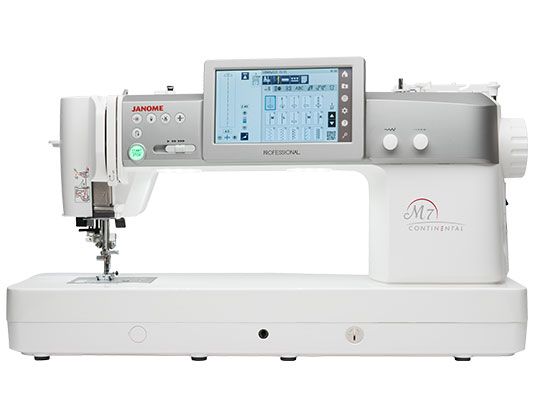 Janome Continental M7 Professional
Janome Continental M7 Professional
My partner, Joe, recently shared with me his top 5 favourite features of the Janome Continental M7 Professional, which he used to sew a very special quilt for me as a surprise birthday present. Joe has tackled a few sewing projects before, so isn’t quite a beginner, but this is the first time he sewed an entire project all on his own, without me guiding or helping him. The Janome Continental M7 Professional was all the help he needed!
 Seeing Double Stars – a free pattern from American Patchwork and Quilting. Yes, I’m a BIG Star Wars fan!
Seeing Double Stars – a free pattern from American Patchwork and Quilting. Yes, I’m a BIG Star Wars fan!
1/4″ Presser Foot with Guide: Janome has many presser feet which help achieve the perfect 1/4 inch seam, which is the hallmark seam allowance used in quilting. See some of the options of Janome 1/4″ presser feet on the Janome HQ You Tube channel. The Janome 1/4 inch presser foot with a guide; the “O” foot comes with the machine and was Joe’s preferred choice to piece the quilt blocks together as he liked having the guide to help improve the accuracy of his seam. He especially loved using it for the many half-square triangles which make up the star points, as he felt that helped him achieve sharp points when he sewed the blocks together.
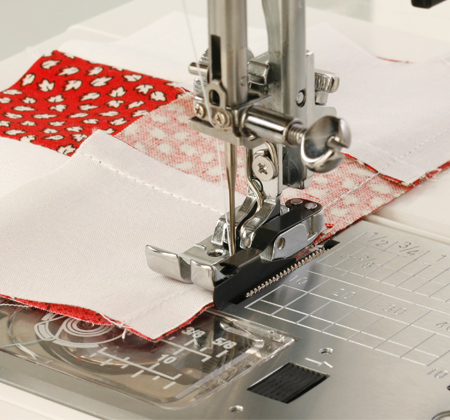 Janome 1/4 inch Presser Foot with Guide comes with or is available for most Janome sewing machines.
Janome 1/4 inch Presser Foot with Guide comes with or is available for most Janome sewing machines.
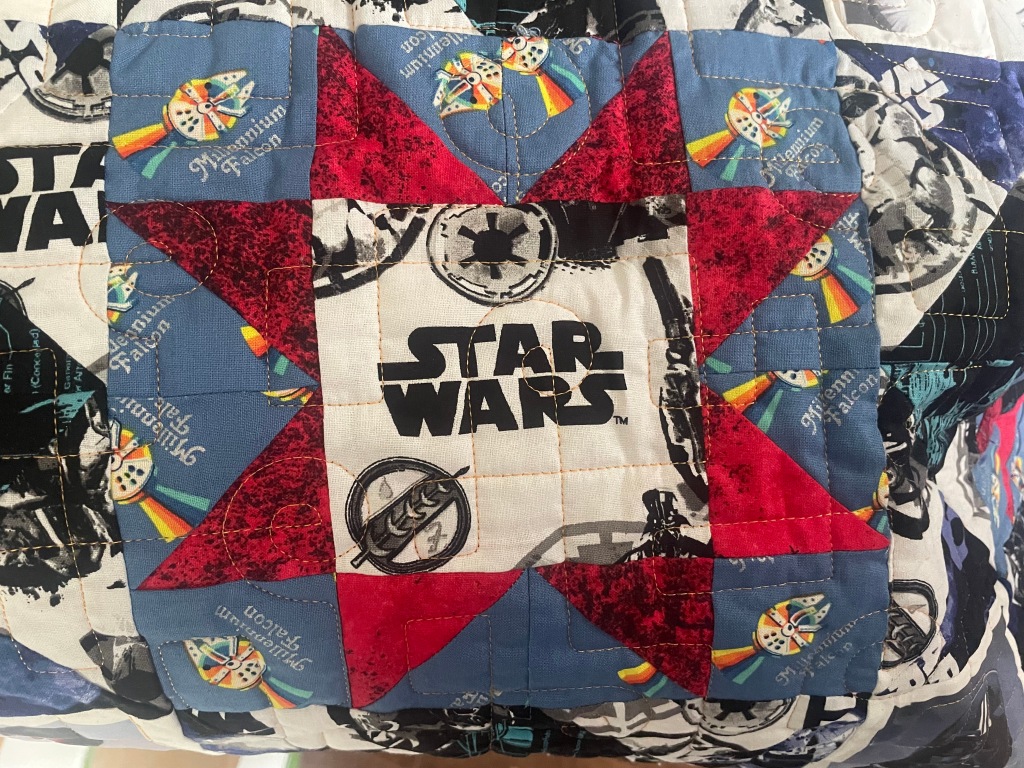 Sharp points of Half-Square Triangles are easy to achieve with the 1/4″ presser foot.
Sharp points of Half-Square Triangles are easy to achieve with the 1/4″ presser foot.
LCD Touch Screen Controls: Along with those 1/4 inch presser feet, there are many ways to achieve an accurate 1/4 inch seam, and a computerized machine like the Janome Continental M7 Professional gives you those choices with just the touch of the screen! Given Joe sewed this quilt on the sly, without my knowledge, he didn’t want to do anything to mess up my machine, so the icons on the large LCD screen did all the machine adjustments for him without any guesswork. It’s great to have a machine do some thinking for us, which minimizes mistakes.
Adjust stitch width to 91 needle positions; adjust stitch length; select the Auto-Pivot icon to automatically keep the needle in the fabric while lifting the presser foot, for example.
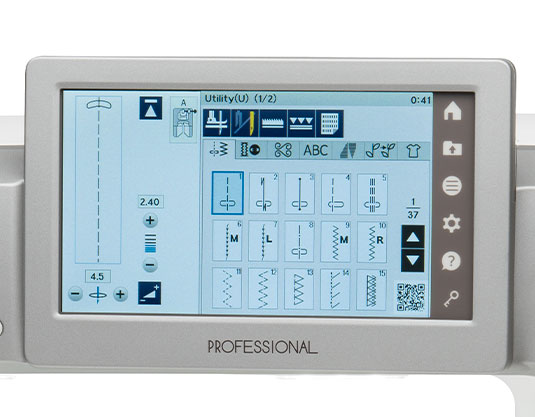 A large 7 inch LCD touch screen makes adjusting the machine a breeze!
A large 7 inch LCD touch screen makes adjusting the machine a breeze!
Or, select the T-shirt icon for the Sewing Applications Menu, which offers a variety of automatic machine adjustments for various sewing functions, like sewing on a button or installing a zipper, and quilting functions, like Ruler Quilting, Free Motion Quilting, and Patchwork. There are sew many adjustments available at your fingertips!
 Janome Sewing Applications Menu built-in to the Continental M7 Professional saves time, and saves possible mistakes by automatically adjusting the machine
with just the touch of the screen!
Janome Sewing Applications Menu built-in to the Continental M7 Professional saves time, and saves possible mistakes by automatically adjusting the machine
with just the touch of the screen!
Workspace: No matter what you’re sewing, you need an ample work area to conveniently and efficiently construct your project. The Janome Continental M7 Professional features an impressive 13.5 inches to the right of the needle by 5.5 inches high. Lots of room for a quilt of any size! Joe also appreciated having the large extension table, which comes included with the machine, so he had lots of room to support the quilt as it grew.
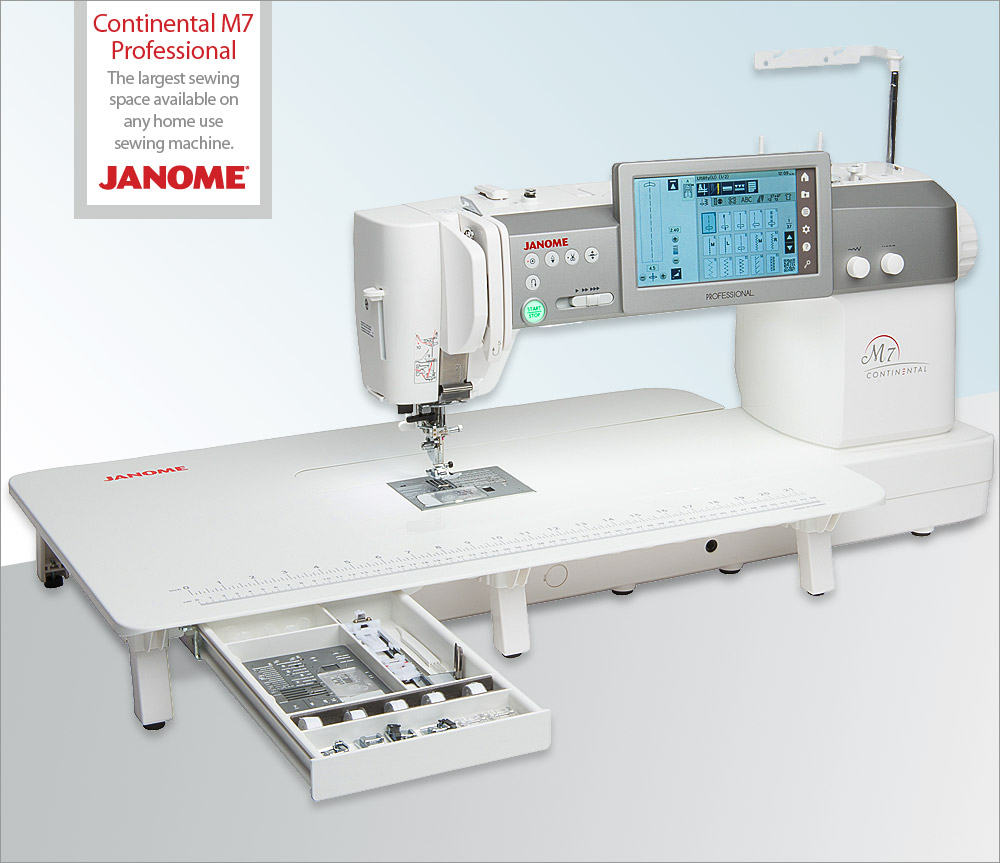 Love, love, love that convenient accessories drawer!
Love, love, love that convenient accessories drawer!
Convenient Push-Button Controls: Since Joe made this quilt while I was out of the house, time was very precious to him, so he made use of the many convenient, time-saving features of the Janome Continental M7 Professional; features which are also built-in to many electronic Janome sewing machines which any sewist will love! Reverse, Lock-Stitch, Needle Up/Down, Scissors, Auto-Presser Foot Lift, and the Speed Control lever are built-in functions conveniently arranged above the needle area, so they’re within easy reach, and help speed up production.

Bright Lighting: Another important feature on any machine is bright lighting so we can see exactly what we’re doing. After all, you can’t achieve accurate results if you can’t see where you’re stitching! Joe loves the abundance of bright LED which washes down all over the bed of the Janome Continental M7 Professional; in the throat space and in two places around the needle. You can even adjust the brightness to suit you, so there’s less strain on your eyes. Joe was often sewing later at night, so having an ample supply of crisp LED lighting helped keep his stitching in order and helped reduce strain and fatigue on his body.
 The Instruction Manual shows how to adjust the lighting in the Settings Menu so you get it where and when you need it.
The Instruction Manual shows how to adjust the lighting in the Settings Menu so you get it where and when you need it.
 With no lights on in the room, there’s plenty of bright LED lighting available from the Janome Continental M7 Professional.
With no lights on in the room, there’s plenty of bright LED lighting available from the Janome Continental M7 Professional.
There are definitely more fabulous features of the Janome Continental M7 Professional which Joe has yet to discover, but he’s off to a great start now that’s he’s truly more comfortable with the machine. The overall ease of use; intuitive, feature-rich controls of the machine make it easy to see why!
I can’t wait to receive my next quilt! (hint, hint, Joe, lol!)
 May the Force be with you in all your sewing endeavors! lol!
May the Force be with you in all your sewing endeavors! lol!
Happy Sewing!
You can test drive a Janome Continental M7 by visiting your Local Janome Dealer, find your Local Dealer HERE.